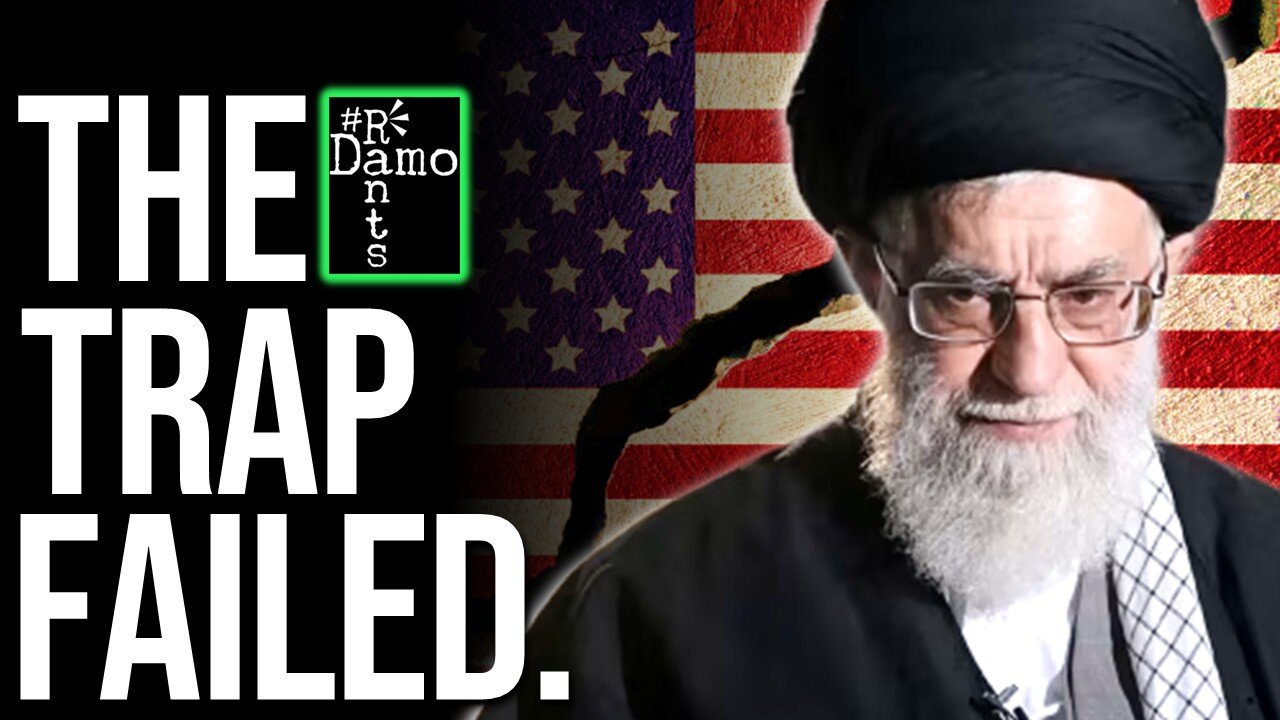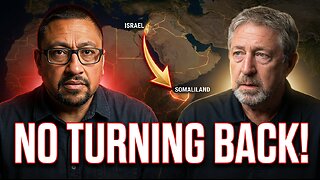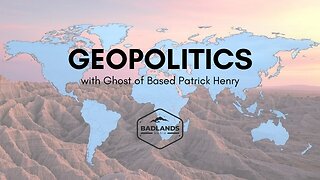Premium Only Content

Washington Declares Iran Surrounded — But the Trap has Backfired Hard
Right, so in the last week, Iranian President Masoud Pezeshkian travelled to Yerevan, the Armenian capital, where he signed ten wide-ranging cooperation agreements with Armenian Prime Minister Nikol Pashinyan. Days later, Tehran also finalised an ambitious agricultural trade package with Pakistan, setting the goal of three billion dollars in annual exchanges, with Islamabad to supply up to sixty percent of Iran’s imported meat. These agreements may appear dull, technical events, the boring politics of normal life, but actually there’s something else going on here. At the very moment when Washington, in deepening its ties to Armenia and Pakistan believed it was successfully isolating Iran from its neighbours, Tehran was actually deepening ties with two of them and two that the US was recently involved with negotiations with at that, so for all of the pro Israel influence the Trump administration might believe it has, it might not be as strong as they thought.
Right, so the United States, under Donald Trump’s second presidency, has revived and sharpened a long-standing policy of isolating the Islamic Republic. Its aim is to weaken Tehran’s capacity to project power by hemming it in diplomatically, economically, and militarily, especially after the damage it wrought on Israel back in June. In the Caucasus, Trump’s administration brokered a new corridor agreement between Armenia and Azerbaijan, designed to secure Israel’s oil supply lines from the Caspian and to deny Iran leverage over Yerevan. In Pakistan, Trump sought to reforge ties by designating Baloch militant groups as terrorist organisations, Balochistan lying pretty much on the border between Pakistan and Iran, flattering Islamabad’s counterterrorism record, and proclaiming a new era of partnership. With Assad toppled in Syria last year, the land corridor connecting Iran to Hezbollah in Lebanon appeared broken. In the Gulf, US alliances with Saudi Arabia, the United Arab Emirates, Bahrain, and Kuwait seemed to provide a southern wall of containment, while Jordan remained a reliable partner for both Washington and Tel Aviv.
On paper, this encirclement strategy looks formidable, looks to be taking shape. Iran appears boxed in: its northern flank compromised by this new Caucasus corridor between Armenia and Azerbaijan, its eastern border tilted toward Washington through Pakistan, its western arc fractured by Assad’s fall, and its southern Gulf neighbours locked into US security guarantees. The White House presents this as a geopolitical success story, proof that Trump’s transactional diplomacy has delivered where previous administrations faltered. That this is how to beat Iran in effect.
Yet the reality on the ground is very different from Trumpian claims. Encirclement has not translated into containment. Far from being abandoned, Iran has been strengthening relations with Armenia and Pakistan. Iraq remains firmly within Tehran’s sphere of influence, no matter how many unwanted US bases remain there and how much Trump might think Iraq are on his side. In Lebanon and Yemen, allies continue to exert pressure on Israel. And in Syria, instability creates new openings for Iranian manoeuvre even as Assad’s departure was hailed as a US victory. The actions of the Al Qaeda terrorist turned unelected President Al Jolani, as pro Israel and pro US as he is, his own attacks on minorities play into into the hands of those disgusted by such things and a destabilised Syria post Assad suits Iran more than an effectively run pro Israel state does. Moreover, the more Washington squeezes, the more Tehran turns eastward toward China and Russia, embedding itself in alternative global networks such as BRICS, where it is now a member and the Shanghai Cooperation Organisation.
Iran is anything but isolated, it is instead adapting, proving more resilient than Washington’s designs would suggest.
To understand the current dynamic, it is important to situate Trump’s encirclement strategy in a historical perspective, because this idea of isolating Iran predates him, he’s only resurrecting an idea people have tried before. Since the 1979 revolution, when the West lost their puppet leader the Shah and therefore control of Iran, the United States has sought to contain the Islamic Republic through sanctions, diplomatic pressure, military bases elsewhere in the region, and regional alliances. During the 1980s, Washington supported Iraq in its war against Iran. In the 1990s, the Clinton administration spoke of “dual containment” of Iran and Iraq. Under George W. Bush, Iran was labelled part of the “Axis of Evil.” Barack Obama’s approach shifted toward diplomacy with the 2015 nuclear deal, but even then the US presence in the Gulf and its support for Israel served as a check on Tehran. Trump’s first presidency marked a return to maximum pressure, with the withdrawal from the Obama era JCPOA in 2018 and the imposition of crippling sanctions. His second presidency, has gone further still, reviving the language of encirclement yet again.
The rationale is straightforward: Iran is perceived as the greatest threat to US and Israeli interests in the region. By building a ring of hostile or compliant states around its borders, Washington believes it can weaken Tehran’s economy, limit its political influence, and constrain its military options. In Trump’s rhetoric, this strategy represents not only a containment of Iran but a rolling back of its influence, dismantling the so-called “Axis of Resistance” that stretches from Tehran to Baghdad, formerly to Damascus, but then onto Beirut, and also Sanaa.
The Caucasus corridor, Zangezur Corridor, brokered by Trump earlier this month, was presented as a strategic masterstroke in line with this encirclement strategy. By integrating Armenia into a US-monitored route with Azerbaijan, on the Iranian border almost, the administration claimed to secure Israel’s oil supplies from Baku while undermining Tehran’s long-standing partnership with Yerevan. In Pakistan, Trump’s designation of Baloch militant groups as terrorists and his praise for Islamabad’s counterterrorism record were cast as a pivot away from Iran and toward US alignment. The fall of Assad, meanwhile, was hailed as the death knell of Iran’s land corridor to Hezbollah in Lebanon. In the Gulf, alliances remained solid. From Washington’s vantage point, the encirclement was nearly complete.
Here's a very simplified image to illustrate all of this. Trump has been forging anti-Iranian ties with Armenia and Azerbaijan at the top, thre’s a small gap between Azerbaijan and Armenia on that border, Zangezur, which separates Azerbaijan from its exclave province, unattached province of Nakchivan, which required going through Iran to reach. No longer going to be the case and a US controlled corridor, right on Iran’s northern border. Turkey is Westernised and facilitating oil transfer to Israel, Iraq is an ally, but the US basically thinks otherwise because of their presence there. Pakistan I’ve also touched on Trump’s butt-kissing exercise there, playing on historic tensions between Pakistan and Iran. The main reason for punching this map is to touch on the other two states that border the region which have not been mentioned yet. Afghanistan, which of course has fallen to the Taliban since the West abandoned it after 20 years of warfare is a no go for Iran as well, since they possibly like the repressive Taliban even less than we do in the West. As for Turkmenistan, it is played down in the media, but as a staunch ally to Russia, it is not exactly anti Iran either, Iran being their largest trade partner outside Russia. In and of itself though, that’s not going to float Iran’s economy, so the idea is by hitting everyone else around Iran, enough economic damage is done. Of course iran having a massive controlling interest in the Persian Gulf means isolation by land, no matter how extensive, still gives Iran options.
Encirclement is not the same as containment you see. States are not chess pieces that can be moved into static positions. They have interests, vulnerabilities, and constraints that compel them to hedge and balance. This becomes clear when examining the northern and eastern flanks of Iran’s neighbourhood here.
Armenia should have been the poster child of Washington’s success. For decades, Yerevan relied on Iran for energy and transit, especially as its borders with Turkey and Azerbaijan were effectively closed. By bringing Armenia into a new corridor with Azerbaijan, the United States hoped to cut off this dependency and pull Yerevan into the Western orbit. Yet Armenia’s behaviour since has shown this not to be the case.
You see Iranian President Masoud Pezeshkian visited Yerevan after Trump left and signed ten memoranda of understanding with Prime Minister Pashinyan whilst he was there. These agreements covered economic cooperation, transport infrastructure, cultural and educational exchanges, energy projects, and health. So far from cooling ties, the two states demonstrated a willingness to broaden them across multiple domains. At the same summit, Pashinyan gave reassurances to Tehran that any transit routes through Armenian territory would remain under full Armenian sovereignty and security control, explicitly ruling out the presence of foreign, meaning US or Israeli, security contractors. This was a direct rebuke to any attempt to internationalise Armenia’s borders in ways hostile to Iran.
Armenia’s motivations are clear. Its geography leaves it little choice. It was the lack of choice that Trump saw as his advantage, but its proven not to be the case at all. Landlocked and encircled by hostile neighbours, Yerevan depends on Iran for access to global markets and for energy security. Iranian gas and electricity continue to be vital to the Armenian economy. The Tehran Times reported that bilateral trade had already reached nearly one billion dollars in 2024, a figure the new agreements are designed to expand further. In April of this year, Reuters reported that Armenia and Iran had even conducted joint military drills, underscoring a security relationship that will endure despite US efforts to undermine it.
Thus, rather than flipping into Washington’s camp, Armenia is hedging. They don’t have a lot of options, they took a US offer, because economically they couldn’t afford too say no, but it hasn’t ended their relationship with Iran and the US are not to set up shop anywhere but the corridor they have leased. It engages with US-backed projects to secure diplomatic goodwill, but it deepens ties with Tehran to secure economic survival. This is precisely the kind of nuance US policymakers overlook. The result is that the encirclement map drawn in Washington fails to reflect the lived realities of Yerevan’s choices.
If Armenia complicates the northern flank, Pakistan complicates the east though. For Trump, the designation of Baloch armed groups as terrorists was a coup. Earlier this month, the US State Department formally added the Balochistan Liberation Army and related groups to its list of foreign terrorist organisations. This was framed as a move to strengthen counterterrorism cooperation with Islamabad, which Washington praised as a success story days later during a joint dialogue. Trump himself lauded Pakistan’s efforts, presenting it as proof that US–Pakistani relations were back on track after years of mistrust.
Yet this move contained a certain Israel shaped irony. For both Tehran and Islamabad, the Baloch insurgency has long been seen as an externally manipulated conflict, they are seen as proxies, proxies of Israel and sometimes India accused of backing militant groups to destabilise Iran’s Sistan-Baluchestan province and Pakistan’s own Balochistan region, the areas where the two nations meet. The Cradle reported that the insurgency was widely regarded as a front in Israel’s covert war against Iran, designed to disrupt not only Iranian stability but also Pakistan’s Gwadar port and the China–Pakistan Economic Corridor. By proscribing the Baloch groups, Washington inadvertently validated Iran’s narrative, even as it sought to box Tehran in.
At the same time, Iran was reaching out to Pakistan with offers of humanitarian assistance. After monsoon floods killed over three hundred people in Pakistan this month, President Pezeshkian sent condolences and pledged aid. The Iranian Red Crescent declared itself ready to dispatch emergency medical teams and relief supplies. Press TV and Tasnim News both reported Tehran’s willingness to provide direct support to affected communities.
Even more significant was the expansion of agricultural trade. Just last week, Iran and Pakistan signed agreements to double their agricultural trade to three billion dollars annually. Pakistan agreed to supply sixty percent of Iran’s imported meat, as well as rice, corn, and maize. Iran in turn would increase its exports of dairy products, nuts, and fruit. Cold chain infrastructure and customs streamlining were promised to make this trade sustainable.
Pezeshkian’s official visit to Islamabad earlier in August further consolidated relations. Alongside Prime Minister Shehbaz Sharif, he signed twelve agreements spanning energy, trade, culture, and security cooperation. Both sides spoke of transforming their long-troubled border into a zone of opportunity rather than tension. The Institute for National Security Studies described this as a strategic pivot, a recognition by both states that their futures were interlinked. Iran’s role in mediating India–Pakistan tensions earlier in 2025 also reinforced this perception. Back in May, Iran’s Foreign Minister Abbas Araghchi travelled to Islamabad to urge de-escalation after the deadly attack in Kashmir, the clash between Pakistan and India, underscoring Tehran’s aspiration to be a stabilising force in South Asia.
Thus, Pakistan is also hedging rather than aligning. It accepts US. designations and praise, but it simultaneously embraces Iranian aid, trade, and diplomacy. Trump may boast of flipping Islamabad, but in reality, Pakistan is binding itself closer to Tehran out of necessity.
The fall of Bashar al-Assad in December 2024 was celebrated in Washington as a decisive blow to Iran. For all of the very justifiable reasons to dislike Assad, the long-standing Syrian leader had been Tehran’s most reliable Arab ally, the linchpin of its land corridor to Hezbollah in Lebanon. When Ahmed al-Sharaa, as the terrorist Al Jolani now prefer to be called, was installed as transitional president in January, and an interim constitution followed in March, many US officials proclaimed that the “Axis of Resistance” had been cut apart. Quiet talks between Syrian and Israeli representatives in Paris were cited as proof that Damascus was slipping out of Tehran’s orbit, with the corridor broken.
Yet this interpretation closes the loop too early. Syria’s transition from Assad to Al Jolani has not brought stability but chaos. The UN envoy warned in February that the ceasefire was tenuous, and by this month the new government has been struggling with spiralling crises: attacks on minorities for months that have left many observers wondering if things have actually improved for Syria or worsened, Israel constantly invading despite Al Jolani wanting relations with them, a plan to redenominate the Syrian currency by dropping two zeros, seizures of two hundred million Captagon pills as Damascus tried to dismantle Assad’s narco-state legacy, and a historic drought that left millions facing wheat shortages and hunger. The Druze minority erupted in protest, with some factions reportedly seeking Israeli support against militia crackdowns, Al Jolani’s war on minorities, religious extremist as he is — a whole host of developments that underscore the fragility of the new Syrian order rather than its resilience.
For Iran, instability is not a barrier but an opening. It is precisely in fractured states that Tehran’s methods of influence — cultivating militias, providing subsidised fuel or food, embedding cultural ties, and inserting advisers — prove most effective. Assad’s fall has disrupted the neat corridor, but it has not eliminated Iran’s capacity to project power. Instead, it has created a more chaotic environment in which Tehran could once again reassert leverage under the cover of disorder. Certainly the chaos does nothing to hinder Iran.
What looked like a US victory therefore risks backfiring. By celebrating Assad’s ouster as the end of Iran’s reach into the Levant, Washington has overlooked the fact that fragile states often provide Tehran with the very conditions it thrives in. Rather than a closed corridor, Syria has become a contested vacuum.
In the Gulf, US alliances remain strong. Saudi Arabia, the United Arab Emirates, Bahrain, and Kuwait are firmly entrenched in Washington’s security umbrella. Yet even here, cracks exist. Qatar maintains warm ties with Tehran, sharing the South Pars gas field. Oman continues its historic role as mediator, balancing relations with all sides. Encirclement here is less than total. Chinese involvement has opened dialogue between Iran and the likes of Saudi Arabia and of course China is a big customer of Iranian oil. Besides, Iran have their own access to the Persian Gulf anyway, they are themselves a Gulf State.
More importantly, Iran’s power is not limited to state-to-state relations. In Iraq, Tehran retains immense influence through Shi’a political parties and militias, such as the PMU. Despite the presence of US troops, Baghdad’s politics remain shaped by Iranian networks. In Lebanon, Hezbollah continues to function despite attempts by the Lebanese government itself to now disarm them whilst still being under attack by Israel. In Yemen, the Houthis remain defiant, launching attacks on Israeli targets such as Ben Gurion airport and blockading Red Sea shipping. These allies, this sea access means that even if Iran were surrounded by land, it would not be contained.
Washington may present Iran as encircled, but containment remains a pipe dream. Armenia continues to hedge, deepening economic and security ties with Tehran. Pakistan, far from aligning, is building structural interdependence with Iran through agriculture and aid. Syria remains unstable, with opportunities for Iran to reassert itself. The Gulf monarchies hedge in places, and Iran’s allies ensure enduring influence. Meanwhile, China and Russia stand ready to provide global backstops, embedding Tehran in alternative economic and security frameworks.
Encirclement without containment is a brittle strategy. It produces headlines in Washington but fails to transform realities on the ground. It is an illusion just to secure some nice headlines for Trump in the right wing media circus. Worse, it risks backfiring by driving Iran’s neighbours into deeper cooperation with Tehran, precisely because US overreach and dishonesty makes them wary of any dependence on Washington.
The attempt to isolate Iran actually illustrates the limits of US power in the multipolar world we actually live in. Encirclement may appear neat on a map, but states hedge and balance and pursue their own interests. Armenia cannot abandon Iran without jeopardising its access to energy and trade. Pakistan cannot alienate Tehran without risking border instability and food insecurity. Syria remains fragile thanks to US and Israeli support for a terror group still designated as such by many Western nations, but who’s leaders are happy to press the flesh with their Al Qaeda leader, whilst certainly as it applies to the UK, support for Palestine can end up seeing you arrested. Iraq remains Iranian supporting, as do allies further afield like the Houthis. The Gulf monarchies hedge even as they host US bases.
Thus, Iran is not isolated but adapting. Always adapting. By offering aid, expanding trade, and leveraging asymmetric tools, it has turned encirclement into an opportunity for resilience. The United States may believe it has boxed in Tehran, but in practice, it has produced a strategy that looks like containment only on paper. Encirclement without containment risks not only failure but strategic backfire, strengthening the very adversary it seeks to weaken.
Speaking of being weakened though, Israel is learning a thing or two about that, now being so desperate for troops, with reservists refusing to report for duty and the absolute failure to force the Ultra Orthodox population to roll over and engage in military service, Netanyahu is now desperately trying to recruit Jewish young people from abroad to fight to seize Gaza and is failing miserably! Get all the details of that story, which is an issue that could have significant bearing over Netanyahu’s designs on Gaza and the West Bank in this video recommendation here as your suggested next watch.
Please do also hit like, share and subscribe if you haven’t done so already so as to ensure you don’t miss out on all new daily content as well as spreading the word and helping to support the channel at the same time which is very much appreciated, holding power to account for ordinary working class people and I will hopefully catch you on the next vid. Cheers folks.
-
 LIVE
LIVE
StoneMountain64
5 hours agoArc Raiders HIGH VALUE LOOT Spots
190 watching -
![[Ep 818] Somali Fraud Fallout & Trump Timeline (too slow?): Guest Shawn Farash Sounds Off!](https://1a-1791.com/video/fwe2/80/s8/1/Q/g/f/M/QgfMz.0kob-small-Ep-818-Somali-Fraud-Fallout.jpg) LIVE
LIVE
The Nunn Report - w/ Dan Nunn
4 hours ago[Ep 818] Somali Fraud Fallout & Trump Timeline (too slow?): Guest Shawn Farash Sounds Off!
153 watching -
 1:06:52
1:06:52
The Quartering
5 hours agoTrump Goes NUCLEAR Over Somalian Scammers, Apocalypse Scammer Busted, Trans Shooter Update!
128K80 -
 2:08:37
2:08:37
James Kaddis
14 hours agoIsrael Just Did This, And There’s No Turning Back!
28.8K7 -
 1:05:22
1:05:22
DeVory Darkins
6 hours agoChicago Mayor HUMILIATED with latest PR stunt as Federal court hands trump MAJOR LEGAL WIN
120K58 -
 1:58:45
1:58:45
The Charlie Kirk Show
7 hours agoMaking An Example of Minnesota + 2025 Retrospective | McLaughlin, Shirley | 12.30.2025
152K121 -
 58:11
58:11
Sean Unpaved
6 hours agoBijan Robinson GOES OFF As Falcons Take Out Rams! | UNPAVED
40.2K1 -
 2:08:12
2:08:12
Side Scrollers Podcast
8 hours agoSOMALI FRAUD BLAMED ON WHITE GUYS + KOTAKU BLAMES TRUMP FOR EVERYTHING + MORE | SIDE SCROLLERS
44.3K10 -
 1:17:13
1:17:13
Adam Does Movies
22 hours ago $0.87 earnedTop 10 BEST Movies Of 2025!
23.7K2 -
 1:37:49
1:37:49
Badlands Media
17 hours agoGeopolitics with Ghost Ep. 69 - December 30, 2025
50K8